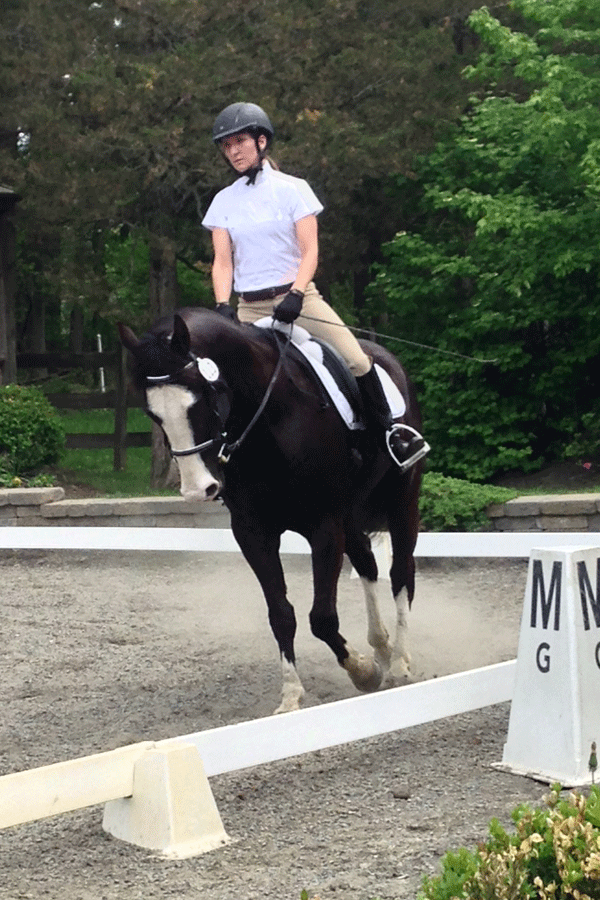In this picture Becky Graham is showing her 9-year-old horse Absolute Alex at Training Level. When looking at a new picture, I always notice the positive characteristics first. In this photo, the words that come to mind are: “concentration” and “mutual trust.”

Becky and Alex appear focused and supple in performing the task of the test. Becky is looking ahead and her face shows that she is fully concentrating without any negative tension. Her horse’s ears are playing at the side, which tells me he is fully listening to his rider and—at least in this picture—he looks bomb-proof in his work, as if nothing could make him lose concentration. Very often, especially in Training Level, inexperience and excitement can lead to negative tension and spoil the performance. Becky and Alex seem to manage this fine.
The angle of the photograph is such that it is difficult to comment on the quality of the horse’s movement. The picture is taken in the moment of the trot when the horse is landing on his inside front leg and outside hind leg. This moment can make a horse look heavier on the inside shoulder than he actually moves. From this perspective, I cannot see how far his hind leg is stepping under the rider’s weight. I do notice that Alex is working on the bit with a tendency to keep his nose behind the vertical. Becky must watch out to allow him to open the frame a bit more forward.
At this moment, the rider is posting during the rising trot. This explains why Becky is not sitting deep but rising a bit higher out of the saddle. Her upper body appears upright and in good balance, but I do notice that her left foot is pointing clearly too far to the outside. Because of this foot position, she should check the amount of tension around her pelvis, especially the seat muscles (gluteal muscles, buttocks).
Try this: Stand on both of your feet with your heels together and your toes pointing outward. You will notice that your seat muscles become tight in order to do this. When standing opposite, with your toes closer together than your heels, your seat muscles can relax and the base of your seat widens. This is why riders who ride with their toes pointing out often have tension in those muscles.
In Becky’s case, I also get the impression that she is rising up more than shifting her weight forward, and to be able to lift herself up, she is pinching her seat muscles so she cannot keep a supple, straight leg position.
Try this: Stand in your stirrups at the trot as if you are in a jumping seat, until you can feel the elasticity of every step of the horse—like little springs in your knees and ankles. This feel should be maintained when returning to the normal rising trot. It can be necessary in the beginning to keep the upper body more forward than usual until this new balance is secured. Imagine this: Your balance is more stable when standing like a sumo wrestler than when standing like a ballerina. But even if your aim is to look like a ballerina, you have to start in an easier position for the balance first.
The balance line of the rider in rising trot should be through the knee and the stirrup, not through the hips and ankle, as in the sitting dressage position. This slightly more forward shift of balance allows an independent and free movement of the lower leg.
To regain control of the lower leg position, Becky can try to deliberately move her lower leg with every step of the horse’s rhythm—one step farther forward, then to the middle position, then slightly back, etc. In the beginning it is easier to concentrate on one leg at a time and to do the exercise in walk. It can be performed later in trot and canter, too. Ideally, both legs can perform the opposite movement at the same time. In the same way, Becky can work on rotating her toes first turned out, then to the middle and then rotated forward. She just needs to remember that this rotation starts from her hip and should be a movement of her whole leg, not only the ankle.
I hope this will help Becky to improve her balance and leg position so that she can continue her work with Absolute Alex further up the levels.
You can submit your high-resolution dressage photo for critique (300 dpi and 4 by 6 inches in size). Or you can send your photo with a link to a short video. Email to DressageToday@AimMedia.com. Turnout in dressage show or clinic-appropriate attire is encouraged. Don’t forget your helmet!
Susanne von Dietze is a leader in equestrian biomechanics. A physiotherapist, licensed Trainer A instructor and judge for dressage and show jumping, she gives lectures and seminars throughout the world, including at the prestigious German Riding Academy in Warendorf. She is a native of Germany and now lives with her husband and three children in Israel, where she competes at the international level. She is the author of two books on the biomechanics of riding:Balance in Movement and Horse and Rider, Back to Back. Find her books at HorseBooksEtc.com.











